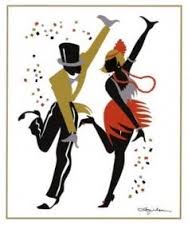Solo 1920s Charleston competitions often utilize elements of the jam circle format, where individual competitors take turns dancing alone for the audience (usually for intervals of a phrase or number of phrases). Competitors move forwards to the audience out of an informal line, usually taking advantage of this movement to perform ‘strolls’ or other ‘traveling’ steps, taking the opportunity to “shine”.
Despite the emphasis on solo dancing in these sorts of competitions, there is often much interaction between competitors and between the audience and competitors, frequently in the employment of comic devices (such as “silly walks” or impersonations) or showy and physically impressive “stunt” moves. This type of interaction is typical of the call and response of West African and Afro-American music and dance. In this call and response, audiences and fellow competitors encourage dancers with cheers, shouts, applause, physical gestures and other feedback.
This sort of competition structure is increasingly popular in Lindy Hop communities around the world, providing added challenges for dancers, new types of pleasure for audiences and emphasizing social dancing skills such as improvisation and musicality. This structure also echoes the cutting contests of jazz music which Ralph Ellison describes in his stories about live jazz music in the 1930s
